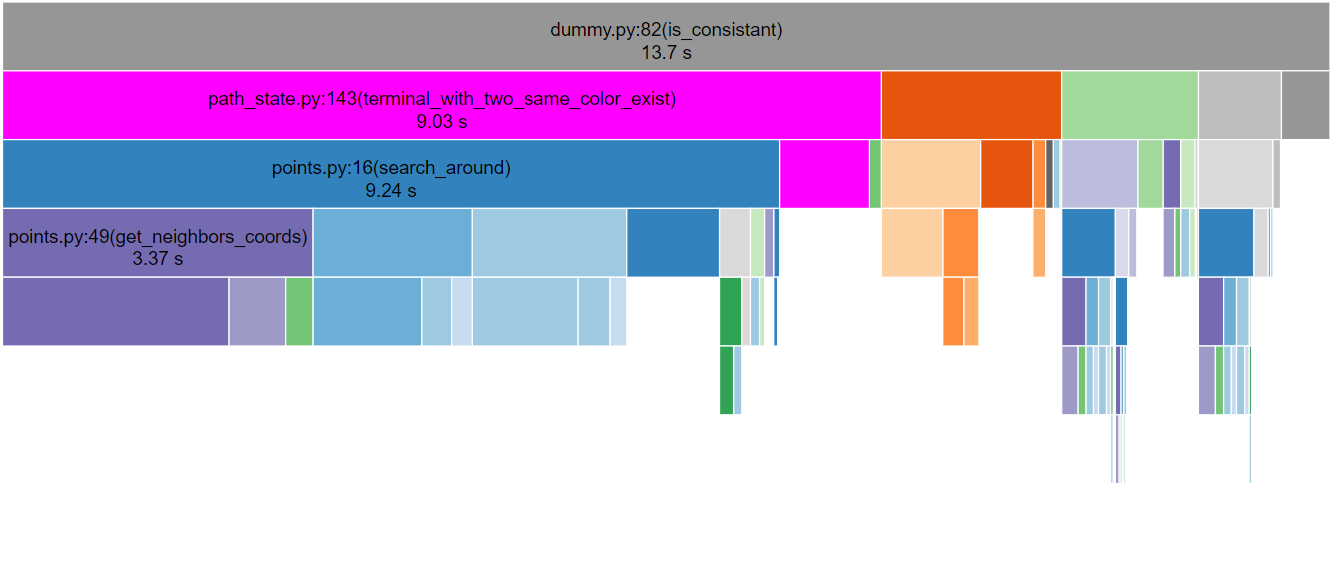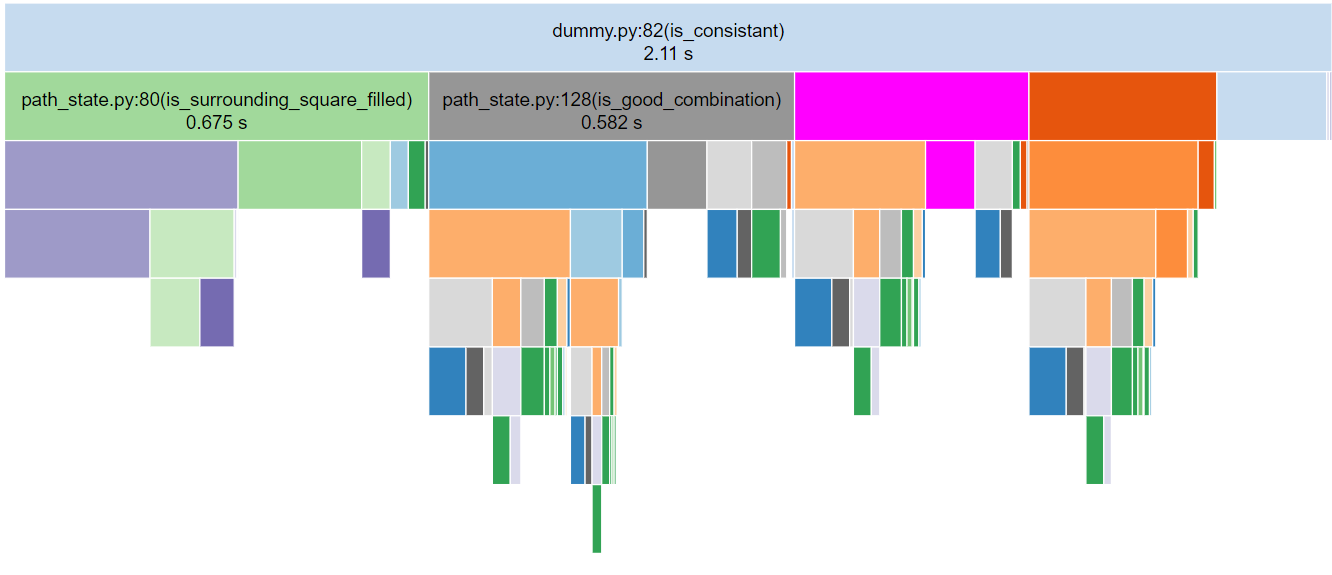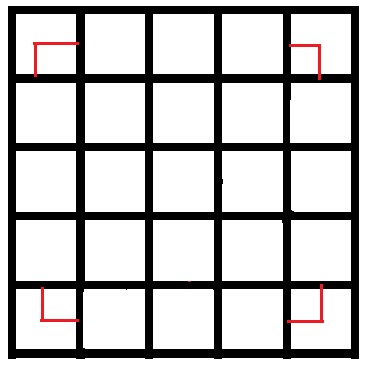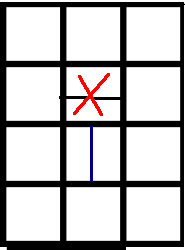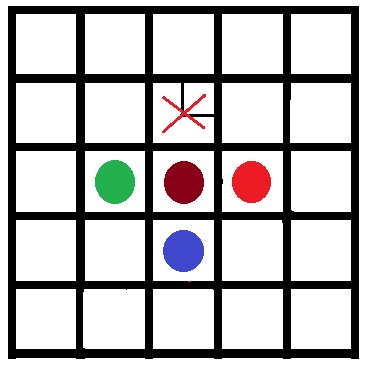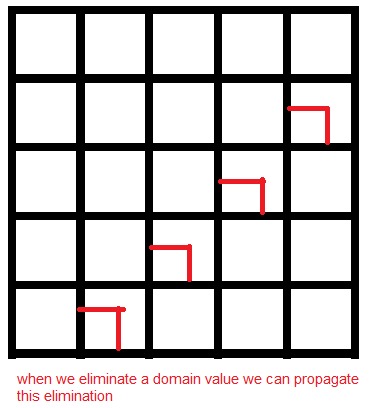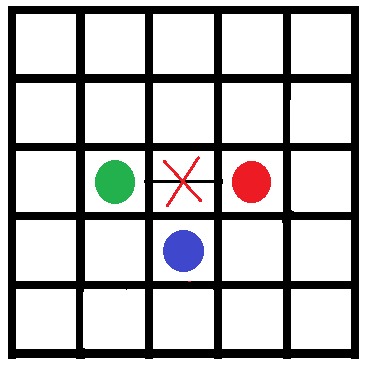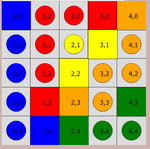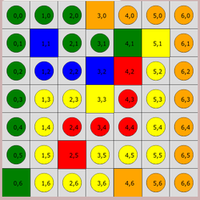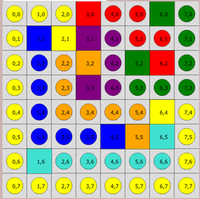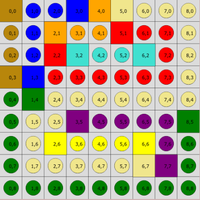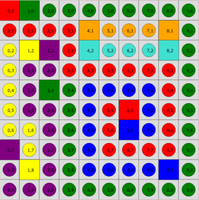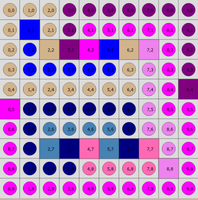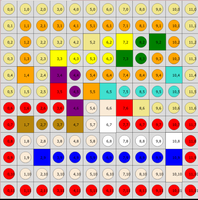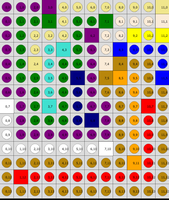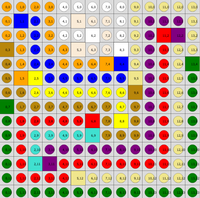Supervisor: Dr. Mahmoud Atef
- table of content
- Flow Free Solver
- problem formulation
- Dumb algorithm
- Smart Algorithm
- optimization
- bonus work for bigger maps
- Smarter solver
- Graphical Results
- Reference
A solver for Flow Free puzzles using back tracking search for CSPs.
Boards are typically a square grid with any number of colors to connect. A well-designed board (an assumption made by this solver) has a unique solution, and requires the entire board to be filled in without any "zig-zagging" paths. A consequence of being an NP-complete puzzle is that, although solutions can be verified quickly, there is no known efficient algorithm to find a solution, and the time required to solve the problem increases very quickly as the board size grows. How do we leverage a computer to quickly find the solution to a given board? We can devise a metric to score potential paths towards the solution, and we investigate the paths that maximize this function first.
cd ./src
python main_dumb.py # for the dumb heuristic
python main_smart.py # for the smart heuristic
python main_smarter.py # for the directional based
# It is recommended to create a separate environment before you install the requirements
pip install -r requirements.txt
cd ./src
python app.pyThese are approaches we took to solve these puzzles, few notes need to be taken before reading. We consider the map as matrix where each element in this matrix is a variable and these variables are coordinates in xy plan, where y grows downwards starting from the top left corner. Assignments are stored in a dictionary-styled data structure where keys are coordinates and values are colors for each coordinate, we use uppercase letters for terminals and lowercase for pipes.
for the map input there are (MxN) variables each one indicate
- the color for it's box for the dump and smart solution
- the direction of movement in smarter solution
each variable is of type character and can take value as representing the color of it
the value can be _ , lower case character or upper case character and values itself depend on map
for example in 5x5
B__RO
___Y_
__Y__
_RO_G
_BG__
- available value are
['_','b','r','o','y','g']for each free variable - each terminal has domain of value equal to its color,
example (0,0) has domain ['B']
here is an example for first five variables in 5X5
| variable | domain |
|---|---|
| (0 0) | ['B'] |
| (0 1) | ['_','b','r','o','y','g'] |
| (0 2) | ['_','b','r','o','y','g'] |
| (0 3) | ['_','b','r','o','y','g'] |
| (0 4) | ['R'] |
| (0 5) | ['O'] |
worth noting here we didn't use numerical representation so we can make the formulas easier to write and debug as formulas became smaller and their number reduced
our approach may be converted to numerical by creating
MxNvariable for each color with domain [0,1]
These are the procedures we took to check the consistency of any new assignments.
Is_good_combination
What we mean by good combination here the state of the selected assignment don't/won't cause any problems. we can wrap them up in the following points
- Number of free neighbors >= 2 => true
- Number of similar neighbors == 1 and Number of similar neighbors == 1 => true
- Number of similar neighbors == 2 and not(is surrounding square filled) => true
- Otherwise => false
those constains are implemented easly for example for varialbe (0 1) in 5x5 map the first constrain would be
with neighbors x_1_1 and x_0_2
Implies(x_0_1 == 'b', OR(
x_1_1 == '_') + (x_0_2 == '_') == 2,
And(x_1_1 == '_')==1 ,(x_0_2 == 'b')==1),
(x_1_1 == 'b') + (x_0_2 == 'b') == 2))
)
and same implies for other colors and neighbor variables
despite being complex but we can easily check this constrain using a for loop and if condition here is python code for it
comb_points_of_interest = [current_assignment_coord]
comb_points_of_interest.extend(
get_neighbors_coords(current_assignment_coord,len(inp),len(inp[0])))
for coord in comb_points_of_interest:
if is_empty(assignments, coord) or assignments[coord].isupper():
continue
good_comb = check_for_good_combinations(
coord, assignments[coord], assignments, inp)
if not good_comb:
return False
return TrueIs_neighbors_terminals_have_valid_path
Checks weather or not any neighboring terminal in locked out, in other word if our newly assigned var : value causes any problem.
Is_terminal_connected
Use the cached on demand updated terminals to check if the same value terminals are already connected, because if so, it doesn't make sense to assign that value to a variable again
For dumb algorithm we used 2 alternative approuches for picking the random variable, totally random variable and the next free variable.
Picking a random value and random variable each time check whether or not this assignment is consultant. If it was consistent move to the next assignment in a DFS-styled backtracking.
| map | time | Number of hits |
|---|---|---|
| 5x5 | 7 ms | 443 |
| 7x7 | +24hrs | ??? |
| ... | ? ms | ??? |
as seen in previous result the total random gave very long run times, so we tried the next dumpiest thing. by just takeing same order as the map, and surpassingly we got some great results .
so the order is:
For free variables pick the first one as next variable starting from (0,0)
| map | time | Number of hits |
|---|---|---|
| 5x5 | 2 ms | 124 |
| 7x7 | 7 ms | 452 |
| 8x8 | 200 ms | 15695 |
| 9x9 | 80 ms | 6208 |
| 10x10 1 | 200 ms | 13396 |
| 10x10 2 | 3 s | 255112 |
| 12x12 | 158 s | 12903209 |
| 12x14 | 5hr 16min | 1548384192 |
| 14x14 | +24hrs | ??? |
5x5:
map ../input/input55.txt solution time = 0.005998373031616211 sec
map ../input/input55.txt number of hits = [443]
BrrRO
bryYo
brYoo
bROoG
bBGgg
7x7 and higher:
TimeOut! more than (24hrs)
5x5:
map ../input/input55.txt solution time = 0.002267599105834961 sec
map ../input/input55.txt number of hits = [124]
BrrRO
bryYo
brYoo
bROoG
bBGgg
7x7:
map ../input/input77.txt solution time = 0.007232666015625 sec
map ../input/input77.txt number of hits = [452]
gggOooo
gBggGYo
gbbBRyo
gyyYryo
gyrrryo
gyRyyyo
GyyyOoo
8x8
map ../input/input88.txt solution time = 0.20182538032531738 sec
map ../input/input88.txt number of hits = [15695]
yyyRrrGg
yBYPprrg
yboOpGRg
yboPpggg
ybooooYy
ybbbBOQy
yQqqqqqy
yyyyyyyy
9x9
map ../input/input991.txt solution time = 0.0804746150970459 sec
map ../input/input991.txt number of hits = [6208]
DbbBOKkkk
dbOooRrrk
dbRQqqQrk
DBrrrrrrk
gGkkkkkkk
gkkPppppG
gkYyyyYpg
gkkkkkKPg
ggggggggg
10x10 1
map ../input/input10101.txt solution time = 0.22327589988708496 sec
map ../input/input10101.txt number of hits = [13396]
RGgggggggg
rrrrOoooOg
yYPrQqqqQg
ypprrrrrrg
ypGgbbbbrg
yppgbrRbrg
yypgbrBbrg
Pypgbrrrrg
pYpgbbbbBg
pppggggggg
10x10 2
map ../input/input10102.txt solution time = 3.133574962615967 sec
map ../input/input10102.txt number of hits = [255112]
tttppppppp
tBtpfffffp
tbTPFBTVfp
tbbbbbtvfp
tttttttvfP
Fnnnnnnvff
fnssssnvvf
fnSNHSNHvf
fnnnhhhhVf
ffffffffff
12x12
map ../input/input1212.txt solution time = 148.92762875556946 sec
map ../input/input1212.txt number of hits = [12903209]
kkkkkkkkkkkk
kooooooooook
kokkkKyYgGok
kokYyyyGgook
kOkPpoooooQk
kkkRpOQqqqqk
rrrrPaARKkkk
rDddDaWrrrrr
raaaaawwwwWr
raBbbbbbbbBr
raaaaaaaaaAr
rrrrrrrrrrrr
12x14
map ../input/input1214.txt solution time = 18969.79822649236564258 sec
map ../input/input1214.txt number of hits = [1548384192]
pppPkkkkkkkK
pggGkggGaaaA
pgkkkgPaaYyY
pgkqQgpaBbbb
pgKqggpADddb
pggqgNpDOodB
ppgqgnpddodd
WpgQgnppdoRd
wpgggnNpdord
wpppppppdord
wwwwwwwWdord
dddddddddOrd
dRrrrrrrrrrd
dddddddddddd
Using a combination of helping heuristics and approaches that can be controlled via config dict in src/algorithms/smart.py including MRV to chose the next variable, LCV for choosing the value, Degree Heuristics as a tie breaker and Weak locker these heuristic are "togglable" due to optimization issues, check optimization labeled PRs for more information.
used combination:
- Forward checking
- MRV (minimum remaining value)
- Degree heuristic
- Least constraining value
- find domain for variables
- if variable has zero domain
- return case failure
def forward_check(variables_domain):
for coords in variables_domain:
if len(variables_domain[coords]) == 0:
return False
return True
5x5
-
without forward_check
map time Number of hits 5x5 7 ms 443 -
with forward_check
map time Number of hits 5x5 9 ms 28
-
find domain for variables
-
choose variables with smallest domain
-
implementation pseudo code
smallest_domain = math.inf
selected_coords = []
for coord in variables_domain:
domain_len = len(variables_domain[coord])
if domain_len < smallest_domain:
selected_coords = []
smallest_domain = domain_len
if smallest_domain == domain_len:
selected_coords.append(coord)
return selected_coords| map | time (s) |
|---|---|
| 7x7 | 1.87 |
| 8x8 | 1.73 |
| 9x9 | 6.87 |
| 10x10 | ?.?? |
-
variable domain calculation increase with map size
-
example
- 14x14 every time calculate domain
for (196 - terminals) variable
- 14x14 every time calculate domain
-
solution
- update only constrained variables
-
-
consistency check represent the bottleneck
terminal constrain was checking every terminal has only on path
check only neighbor terminals this improved performance significantly
| map | time (s) |
|---|---|
| 7x7 | 0.085 |
| 8x8 | 0.157 |
| 9x9 | 0.858 |
| 10x10(1) | 3.300 |
| 10x10(2) | 1.680 |
| 12x12 | 14.971 |
| 12x14 | ??.??? |
check surrounding squares "zigzag" only when have 2 same color neighbors. Because if we have a good combination we are in one of these two cases
- only one free neighbor and same color neighbor (no squares)
- only 2 or more free neighbors (no squares)
def check_for_good_combinations(coord, current_color, assignments, inp):
empty_neighbors = search_around(coord, inp, assignments, is_empty)
if len(empty_neighbors) >= 2:
return True
same_color_neighbors = get_same_color_neighbors(
coord, current_color, assignments, inp)
if len(same_color_neighbors) == 2:
# we don't need is surrounding square anywhere but here
ssf = is_surrounding_square_filled(assignments,inp,coord)
return not ssf
if len(empty_neighbors) == 1 and len(same_color_neighbors) == 1:
return True
return False| map | time (s) |
|---|---|
| 10x10(1) | 2.26 |
| 10x10(2) | 1.09 |
| 12x12 | 8.72 |
| 12x14 | ??.??? |
We can cache connected terminals to quickly check whether or not the selected value is consistent
Using a shared object between backtracks that gets updated only when a variable is consistent
Inside backtrack
if is_consistant(initial_state, {var: value}, assignments, inp, connected_terminals):
before_assgen_connected_terminal = connected_terminals
refreshed_connected_terminals = refresh_connected_terminals( {var: value}, assignments, connected_terminals, initial_state, inp)| map | time (s) |
|---|---|
| 10x10(1) | 1.49 |
| 10x10(2) | 0.728 |
| 12x12 | 5.38 |
| 12x14 | ??.??? |
- save variable domain
- only update constrained variables
- are empty neighbor (point good combination)
- are empty neighbor for occupied neighbor
(point neighbors/terminal combination) - every point when terminal is connected (terminal connected)
implementation
variables_domain = {}
connection_changed = len(connected_terminals)>len(prev_connected_terminal)
first_run = prev_variable == None
if connection_changed or first_run:
# update all variables
for coord in variables:
domain = get_available_domain(coord,
assignments,connected_terminals)
variables_domain[coord] = domain
else:
variables_domain = pickle.loads(pickle.dumps(prev_domain))
del variables_domain[prev_variable]
big_neighbors = get_constrained_neighbors(prev_variable,inp,assignments )
for coord in big_neighbors:
domain = get_available_domain(coord, assignments, inp,connected_terminals)
variables_domain[coord] = domain
return variables_domain| map | time | Number of hits |
|---|---|---|
| 5x5 | 6 ms | 17 |
| 7x7 | 16 ms | 41 |
| 8x8 | 30 ms | 52 |
| 9x9 (1) | 57 ms | 67 |
| 10x10 (1) | 189 ms | 320 |
| 10x10(2) | 93 ms | 139 |
| 12x12 | 290 ms | 331 |
| 12x14 | 193 ms | 148 |
| 14x14 | 7875 ms | 10309 |
- use as tie breaker
- choose variable that constrain others implementation
most_constraining_count = -math.inf
for coord in variables:
constrained_count = len(
get_constrained_neighbors(coord,inp, assignments))
if constrained_count > most_constraining_count:
most_constraining_count = constrained_count
most_constraining_var = coord
return most_constraining_var- didn't improve
- made heuristic optional
- choose value that doesn't affect domains
implementation
count_value_ordered = []
for value in domain:
updated_variable_domains = get_available_domain_multiple(
{**{coord: value}, **assignments}, inp, coord,)
count_constrained = 0
for coord in updated_variable_domains:
if len(updated_variable_domains[coord]) < len(variables_domain[coord]):
count_constrained += 1
count_value_ordered.append((count_constrained, value))
count_value_ordered.sort()
order_domain_values = []
for count, value in count_value_ordered:
order_domain_values += value
return order_domain_values| map | time | Number of hits |
|---|---|---|
| 5x5 | 5 ms | 17 |
| 7x7 | 16 ms | 56 |
| 8x8 | 23 ms | 52 |
| 9x9 (1) | 65 ms | 100 |
| 10x10 (1) | 166 ms | 330 |
| 10x10(2) | 240 ms | 482 |
| 12x12 | 838 ms | 1178 |
| 12x14 | 163 ms | 146 |
| 14x14 | 2230 ms | 2374 |
5x5
map ../input/input55.txt solution time = 0.005002737045288086 sec
map ../input/input55.txt number of hits = [17]
BrrRO
bryYo
brYoo
bROoG
bBGgg
7x7
map ../input/input77.txt solution time = 0.01697063446044922 sec
map ../input/input77.txt number of hits = [56]
gggOooo
gBggGYo
gbbBRyo
gyyYryo
gyrrryo
gyRyyyo
GyyyOoo
8x8
map ../input/input88.txt solution time = 0.023000001907348633 sec
map ../input/input88.txt number of hits = [52]
yyyRrrGg
yBYPprrg
yboOpGRg
yboPpggg
ybooooYy
ybbbBOQy
yQqqqqqy
yyyyyyyy
9x9
map ../input/input991.txt solution time = 0.06594991683959961 sec
map ../input/input991.txt number of hits = [100]
DbbBOKkkk
dbOooRrrk
dbRQqqQrk
DBrrrrrrk
gGkkkkkkk
gkkPppppG
gkYyyyYpg
gkkkkkKPg
ggggggggg
10x10 1
map ../input/input10101.txt solution time = 0.16699814796447754 sec
map ../input/input10101.txt number of hits = [330]
RGgggggggg
rrrrOoooOg
yYPrQqqqQg
ypprrrrrrg
ypGgbbbbrg
yppgbrRbrg
yypgbrBbrg
Pypgbrrrrg
pYpgbbbbBg
pppggggggg
10x10 2
map ../input/input10102.txt solution time = 0.24605417251586914 sec
map ../input/input10102.txt number of hits = [482]
tttppppppp
tBtpfffffp
tbTPFBTVfp
tbbbbbtvfp
tttttttvfP
Fnnnnnnvff
fnssssnvvf
fnSNHSNHvf
fnnnhhhhVf
ffffffffff
12x12
map ../input/input1212.txt solution time = 0.8389444351196289 sec
map ../input/input1212.txt number of hits = [1178]
kkkkkkkkkkkk
kooooooooook
kokkkKyYgGok
kokYyyyGgook
kOkPpoooooQk
kkkRpOQqqqqk
rrrrPaARKkkk
rDddDaWrrrrr
raaaaawwwwWr
raBbbbbbbbBr
raaaaaaaaaAr
rrrrrrrrrrrr
12x14
map ../input/input1214.txt solution time = 0.16399812698364258 sec
map ../input/input1214.txt number of hits = [146]
pppPkkkkkkkK
pggGkggGaaaA
pgkkkgPaaYyY
pgkqQgpaBbbb
pgKqggpADddb
pggqgNpDOodB
ppgqgnpddodd
WpgQgnppdoRd
wpgggnNpdord
wpppppppdord
wwwwwwwWdord
dddddddddOrd
dRrrrrrrrrrd
dddddddddddd
14x14
map ../input/input1414.txt solution time = 2.230055093765259 sec
map ../input/input1414.txt number of hits = [2374]
oooowwwwwkkkkk
oBbowAaawkpppk
oobowwWawkpRPk
DobooAaaWkprkk
dobboooOBkprkG
dOYbbbbbbKprkg
ddyyyyyyyDprkg
Gdddddddydprkg
grrrrrRdYdprkg
grqqqqQdddprkg
grqpppppppprkg
grQPrrrrrrrrkg
grrrrKkkkkkkkg
gggggggggggggg
This is the final optimization.
In this part, we tried a totally different approach that is more efficient than all past approaches because it offers an excellent constraints propagation technique (arc consistency). We used directions as a domain for all variables instead of colors. So we have 6 different directions:
-
variables = all empty squares in HxW input matrix (Xij) where ‘i = y-index & j = x-index’
-
domain = {'└', '┌', '│', '┘', '─', '┐'}
we had also assistant variables (colors : Cij, domain: input colors) used to check that the same colors sources are connected but in some simple cases (like 5x5 map) there is no need of them
all border variables have special domains, four corner variables have one value domain and other border variable have 3 values domain.
domain[(0, 0)] = {'┌'}
domain[(h-1, 0)] = {'└'}
domain[(h-1, w-1)] = {'┘'}
domain[(0, w-1)] = {'┐'}
domain[(0, i)] = {'┌', '┐', '─'}
domain[(i, 0)] = {'└', '┌', '│'}
domain[(h-1, i)] = {'└', '┘', '─'}
domain[(i, w-1)] = {'┐', '┘', '│'}
domain[(i, j)] = {'└', '┌', '│', '┘', '─', '┐'}
there are a lot of assignment constraints. We will put here some examples of them, the rest of constraints are in the code and can be deducted also.
1-If there is a square Xij that had value '┘' , then its upper square Xi-1,j (if it is not source square) must have the value '│', otherwise there will be a zigzag. This can be formed in pseudo-code:
constraint_1 = [ Implies(Xij == '┘' , THEN: Xi-1,j = '│' ]
2- If there is a square Xij that had value '┘' , then its left square Xi,j-1 (if it is not source square) must have the value '─', otherwise there will be a zigzag. This can be formed in pseudo-code:
constraint_2 = [ Implies(Xij == '┘' , THEN: Xi-1, j = '─' ]
3- If there f there is a square Xij that had value '│' , then its upper square Xi-1,j (if it is not source square) must NOT have the values '─', '┘', '└' otherwise there will be a cross in the path. This can be formed in pseudo-code:
constraint_3 = [ Implies(Xij == '│' , THEN: Xi-1, j != '─' AND Xi-1, j != '┘' AND Xi-1, j != '└' ]
if(is_in_domain[(i-1, j)]):
delete_corner(inp, ['┘', '└'], (i-1, j), domains,
Num_of_domain_values, domain_levels, assigns)
reduce_domain(['─'], (i-1, j), domains,
Num_of_domain_values, domain_levels, assigns)
every source have at most 4 neighbors (up , down, right, left) and it must be connected to one of them. For example: if the right, left and down squares of a source are also sources, then its upper square must have value of '┌', '│' and '┐'. so it must NOT have a value of '┘' or '─' or '└'.
if(len(terminal_domain[terminal]) == 1):
direction = terminal_domain[terminal]
if(direction == 'UP'):
delete_corner(inp, ['┘', '└'], (i-1, j), domains, Num_of_domain_values, domain_levels, [])
reduce_domain(['─'], (i-1, j), domains, Num_of_domain_values, domain_levels, [])
there are some squares that are related together. For example : if the upper left corner had the value ‘┌’ then its lower right square must have the same value. Otherwise there will be a zigzag or cross. This continues until hitting a color source square:
so if we know that some value is wrong for some variable and we removed it from this variable domain, then it should remove it from related squares also:
if there is two sources having DIFFERENT colors and can be connected with one line, then we could remove this line from domain:
#xij is a terminal where I is y index and j is x index
if((is_in_terminals[(i, j+2)]) and (color[i][j+2] != color[i][j]) and is_in_empty_squares[(i, j+1)]):
reduce_domain(['─'], (i, j+1), domains, Num_of_domain_values, domain_levels)
we firstly look for the least domain length variables (that have one value in its domain) and then we start assigning the variables that have two values in domain. We used depth first recursion and backtrack. So we have a TWO branching-factor recursion (Binary tree). This is an excellent branching factor compared to other ways. We used a heuristic values that is corner value for border squares {'└', '┌', '┘', '┐'} and straight lines {'─', '│'} otherwise.
def backtrack(inp, terminals, terminal_domain, domains, Num_of_domain_values, domain_levels, assigns, colors, is_in_domain, is_in_terminals):
if(len(assigns) == len(domains)):
return assigns
_terminal_domain = copy.deepcopy(terminal_domain)
_domains = copy.deepcopy(domains)
_Num_of_domain_values = copy.deepcopy(Num_of_domain_values)
_domain_levels = copy.deepcopy(domain_levels)
_assigns = copy.deepcopy(assigns)
_colors = copy.deepcopy(colors)
location, direction = get_heuristic(inp, _domain_levels[1], _domains)
_domain_levels[1].remove(location)
Assign(inp, direction, location, terminals, _terminal_domain, _domains, _Num_of_domain_values,
_domain_levels, _assigns, _colors, is_in_domain, is_in_terminals)
is_consistant = apply_arc_consistency(inp, terminals, _terminal_domain, _domains,
_Num_of_domain_values, _domain_levels, _assigns, _colors, is_in_domain, is_in_terminals)
if(is_consistant):
res = backtrack(inp, terminals, _terminal_domain, _domains, _Num_of_domain_values,
_domain_levels, _assigns, _colors, is_in_domain, is_in_terminals)
if(res != False):
return res
domains[location].remove(direction)
dire = min(domains[location])
domain_levels[1].remove(location)
Assign(inp, dire, location, terminals, terminal_domain, domains, Num_of_domain_values,
domain_levels, assigns, colors, is_in_domain, is_in_terminals)
iss_consistant = apply_arc_consistency(inp, terminals, terminal_domain, domains,
Num_of_domain_values, domain_levels, assigns, colors, is_in_domain, is_in_terminals)
if(iss_consistant):
_res = backtrack(inp, terminals, terminal_domain, domains, Num_of_domain_values,
domain_levels, assigns, colors, is_in_domain, is_in_terminals)
if(_res != False):
return _res
return False
-
in some smaller maps(5x5) all variables are initially assigned , so we didn’t need recursion for this map.
-
in the worst case (biggest map : 14x14) there was about 47% of variables assigned initially and this is a very good result that reduced the unkown variables size to almost half.
-
the branching factor (2) is very small compared to color-approach (using colors some times causes a branching factor of 7 or 8.
| Map | time | Number of assignments(hits) |
|---|---|---|
| 5X5 | 0.4 ms | 15 |
| 7x7 | 0.8 ms | 39 |
| 8x8 | 0.7 ms | 50 |
| 9x9 | 1.8 ms | 75 |
| 10x10(1) | 2.9 ms | 102 |
| 10x10(2) | 3 ms | 126 |
| 12x12 | 5.7 ms | 177 |
| 12x14 | 5.8 ms | 186 |
| 14x14 | 6.6 ms | 193 |
5x5:
Result:
B┌─RO
││┌Y│
││Y┌┘
│RO┘G
└BG─┘
---------------------------------
map ../input/input55.txt solution time = 0.0004048347473144531 sec
number of variables: 39
7x7:
Result:
┌─┐O──┐
│B└─GY│
│└─BR││
│┌─Y│││
││┌─┘││
││R┌─┘│
G└─┘O─┘
---------------------------------
map ../input/input77.txt solution time = 0.0008220672607421875 sec
8x8:
Result:
┌─┐R─┐G┐
│BYP┐└┐│
││┌O│GR│
│││P┘└─┘
││└──┐Y┐
│└──BOQ│
│Q────┘│
└──────┘
---------------------------------
map ../input/input88.txt solution time = 0.0007193088531494141 sec
9x9
Result:
D┌─BOK──┐
││O─┘R─┐│
││RQ──Q││
DB└────┘│
┌G┌─────┘
│┌┘P───┐G
││Y───Y││
│└────KP│
└───────┘
---------------------------------
map ../input/input991.txt solution time = 0.0018935203552246094 sec
10x10 1
Result:
RG───────┐
└──┐O───O│
┌YP│Q───Q│
│┌┘└────┐│
││G┐┌──┐││
│└┐││┌R│││
└┐││││B┘││
P││││└──┘│
│Y││└───B│
└─┘└─────┘
---------------------------------
map ../input/input10101.txt solution time = 0.002902984619140625 sec
10x10 2
Result:
┌─┐┌─────┐
│B││┌───┐│
││TPFBTV││
│└───┘││││
└─────┘││P
F┌────┐│└┐
││┌──┐│└┐│
││SNHSNH││
│└─┘└──┘V│
└────────┘
---------------------------------
map ../input/input10102.txt solution time = 0.003052949905395508 sec
12x12
Result:
┌──────────┐
│┌────────┐│
││┌──K┌Y┌G││
│││Y──┘G┘┌┘│
│O│P┐┌───┘Q│
└─┘R│OQ───┘│
┌──┘P┌ARK──┘
│D──D│W└───┐
│┌───┘└───W│
││B───────B│
│└────────A│
└──────────┘
---------------------------------
map ../input/input1212.txt solution time = 0.005738496780395508 sec
12x14
Result:
┌──P┌──────K
│┌─G│┌─G┌──A
││┌─┘│P┌┘Y─Y
│││┌Q│││B──┐
││K│┌┘│AD─┐│
│└┐││N│DO┐│B
└┐│││││└┐│└┐
W││Q││└┐││R│
││└─┘└N│││││
│└─────┘││││
└──────W││││
┌───────┘O││
│R────────┘│
└──────────┘
---------------------------------
map ../input/input1214.txt solution time = 0.005768537521362305 sec
14x14 Result:
┌──┐┌───┐┌───┐
│B┐││A─┐││┌─┐│
└┐││└─W││││RP│
D││└┐A─┘W│││┌┘
││└┐└──OB││││G
│OY└────┘K││││
└┐└─────┐D││││
G└─────┐││││││
│┌────R│Y│││││
││┌───Q└─┘││││
│││┌──────┘│││
││QP┌──────┘││
│└──┘K──────┘│
└────────────┘
---------------------------------
map ../input/input1414.txt solution time = 0.006555795669555664 sec
| Map | time (dump) | time(smart) | time(smarter) |
|---|---|---|---|
| 5X5 | 2 ms | 5 ms | 0.4 ms |
| 7x7 | 7 ms | 16 ms | 0.8 ms |
| 8x8 | 200 ms | 23 ms | 0.7 ms |
| 9x9 | 80 ms | 65 ms | 1.8 ms |
| 10x10(1) | 200 ms | 166 ms | 2.9 ms |
| 10x10(2) | 3 s | 240 ms | 3 ms |
| 12x12 | 158 s | 838 ms | 5.7 ms |
| 12x14 | 5hr 16min | 163 ms | 5.8 ms |
| 14x14 | - | 2230 ms | 6.6 ms |
| Map | Number of assignments(dump) | Number of assignments(smart) | number of assignments(smarter) |
|---|---|---|---|
| 5X5 | 124 | 17 | 15 |
| 7x7 | 452 | 56 | 39 |
| 8x8 | 15695 | 52 | 50 |
| 9x9 | 6208 | 100 | 75 |
| 10x10(1) | 13396 | 330 | 102 |
| 10x10(2) | 255112 | 482 | 126 |
| 12x12 | 12903209 | 1178 | 177 |
| 12x14 | 1548384192 | 146 | 186 |
| 14x14 | - | 2374 | 193 |
5x5:
7x7
8x8
9x9
10x10 1
10x10 2
12x12
12x14
14x14
Russell, S. J. (2016). Artificial intelligence: A modern approach. Harlow: Pearson.
